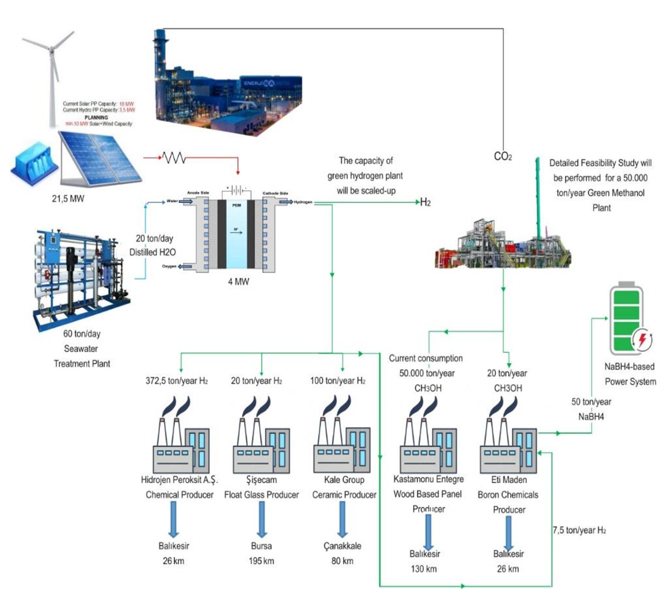Hydrogen energy is an important element in the push towards the deep decarbonisation of the energy system. Hydrogen technologies have been at the center of discussions about the future of energy in recent years. Huge investments are planned in hydrogen technologies for purposes to reduce carbon emissions, energy security, and flexibility in energy supply chains. Hydrogen has great potential to replace fossil fuels for industrial and domestic applications, as well as being used in industrial processes and as a sustainable fuel. Hydrogen to make a significant contribution to clean energy transitions, it needs to be adopted in sectors where it is almost completely absent, such as transport, buildings, and power generation.
Green hydrogen is produced by using electricity to power an electrolyser that splits the hydrogen from water molecules. This process produces pure hydrogen, with no harmful by-products. An added benefit is that, because this method uses electricity, it also offers the potential to divert any excess electricity – which is hard to store (like surplus wind power) – to electrolysis, using it to create hydrogen gas that can be stored for future energy needs. Hydrogen produced by electrolysis method can be considered clean and sustainable. In recent years, these technologies have been rapidly evolving to improve the performance, efficiency and durability of electrolysis and fuel cell systems.
A ROADMAP TO 2050, which states that the goal before 2030 is to rapidly reduce carbon emissions from the hydrogen production process and develop other forms of low-carbon hydrogen to support the transition to renewable-energy hydrogen production.
“Hydrogen is today enjoying unprecedented momentum. The world should not miss this unique chance to make hydrogen an important part of our clean and secure energy future.”Dr. Fatih Birol, Executive Director of the International Energy Agency
To smooth the path toward green hydrogen adoption and scale-up, the International Energy Agency (IEA) and European Commission (EC) recently introduced the concept of hydrogen valleys—also known as hydrogen ‘hubs’—as a starting point to accelerate investments in green hydrogen supply and demand. Hydrogen Valleys have become a global phenomenon. As defined by the Clean Hydrogen Partnership, a Hydrogen Valley is a geographical area – a city, a region, an island or an industrial cluster – where several hydrogen applications are combined into an integrated hydrogen ecosystem that consumes a significant amount of hydrogen, improving the economics behind the project. It should ideally cover the entire hydrogen value chain: production, storage, distribution, and final use (Figure 1).
A hydrogen valley is essentially a project (usually funded by local, national and international funds) that clusters several industrial and research initiatives to carry out pilot projects across the complete hydrogen value chain (production, transport, distribution, and end use with storage sometimes in the mix). Currently, Hydrogen Valleys go beyond simple R&D projects as they are large in scale: indeed, the project scope entails at least a two-digit multi-million euros investment. Then, they all have a clearly defined geographic scope and a broad value chain coverage, covering multiple steps in the hydrogen value chain. In these ecosystems the production and consumption of hydrogen is facilitated locally and supply of various end sectors.

"Hydrogen will be essential to replace natural gas, coal and oil in hard-to-decarbonise sectors in industry, mobility and energy. Hydrogen Valleys will become an important cornerstone in producing, importing, transporting, and using clean hydrogen in Europe. I expect other geographies to follow similar strategies (hydrogen hubs, clusters, ecosystems, etc.), as local agglomerations of various hydrogen users, shared infrastructure and joint supply sources are essential to scale the industry and take the 'New Hydrogen Economy' to the next level….."
Bart Biebuyck, Executive director of the Clean Hydrogen Partnership
https://h2v.eu/hydrogen-valleys
Companies and governments looking to boost their decarbonization strategy by entering the green hydrogen economy should consider hydrogen valleys as a place to start. By identifying innovative actors and tangible projects, and leveraging co-location to foster collaboration and co-investment, hydrogen valleys catalyze green hydrogen projects that will be replicable and scalable. Before entering the green hydrogen economy, it is critical to locate the right geography, conduct due diligence on investors and projects, and carefully analyze the feasibility as well as local regulations. Bold steps should only be taken with the requisite caution to ensure success. Numerous regions are committed to hydrogen development, and many are moving forward with projects to create hydrogen valleys (Figure 2). Moreover, the NextGen-EU funds can also be a mechanism to promote these types of projects throughout the European Union, as they combine some of the key objectives of these grants: boosting innovation, ecological transition, economic recovery, territorial cohesion and the fight against climate change. EU has the goal to create 100 hydrogen valleys by the end of 2030.

The first hydrogen valley of Turkey will be established in South Marmara Region. HYSouth Marmara is a small-scale hydrogen valley project funded by EU, addressing the requirements of the EU call, by bringing together core elements: production, distribution, storage and local end-use of hydrogen into a fully integrated and functioning Hydrogen Valley (Figure 3). Sabancı University is the core partner of this project in which Selmiye A. Gürsel, Bora Ş. Güray, Alp Yürüm and Bülent Çatay are involved in the project
